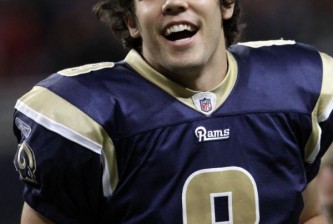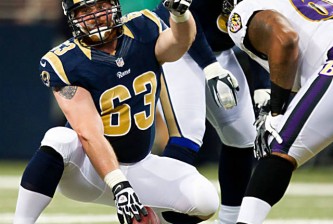
Another week, another big loss. You know it’s bad when even the bye week is beating you, but there’s no other way to put it when you get in only two practices (thank you “player safety” rules in the new CBA) still manage to lose your top cornerback and your #1 receiver for the year.
The Rams also lost ground in the NFC West, as both the 49ers and Seahawks had impressive wins. With San Francisco now 4-1 and in complete command, fulfilling our preseason goals of winning the divison and making the playoffs is going to be that much harder to do.
While those are worthy goals in any season, they can no longer be the focus. The Rams need to focus on much more immediate goals, day-to-day and week-to-week improvement, to get back to where they need to be. Looking ahead, and following a new script, here is a step-by-step plan for how the Rams can salvage something positive out of this season.
1. Renew a commitment to details.
Steve Spagnuolo has no illusions about his team’s need to progress.
“People credit us with making a big jump from Year One to Year Two, but the big jump was only because things were so bad in Year One,” he told SI.com’s Jim Trotter. “We’ve got so far to go. When I broke us down after last year, what I saw was that we played pretty good defense the first half of the season, but I don’t think the schedule was as strong. Then the second half of the season, whether we wore down or were playing better teams, we didn’t play as well. I don’t think we can play that type of defense this season and get what we want.“
So far, his words have been eerily prophetic. But with the defense directly under his control, it’s fair to ask why we we’ve seen a big jump backwards. Part of the problem is the dicohotomy between playing smart and playing aggressively. Of course you’d like to have both, but Spags has asked his men to err on the side of aggressiveness, starting with his defensive captain, James Laurinaitis.
“James is smart, and he’s really good at the finesse things we give him, but I want him to take the next step and sometimes not play perfect. Just worry about knocking the guy over in front of him.”
This attitude of simply hitting the guy in front of you, or penetrating at the cost of losing gap integrity, or jumping into a penalty flag, has been killing the Rams on defense. It’s time to tighten up the screws, particularly in the front seven.
2. Be Ray Charles to the negativity.
I love the fact that more Rams took to Twitter during the offseason. It’s a great way to reach out to fans, particularly for new players, in a free-ranging environment free of the usual controls of the press conference or PR-approved soundbyte. But as Patty Hies of 101Sports.com writes, the two-way channel can provide a non-stop squawk of negative feedback when the times are tough.
Some players have different ways of dealing with this, from responding to critics to going silent, but Chris Long took it a step further — he simply deleted his account.
I won’t criticize Long for this move. Social media is nice to have, and I admire the fortitude of the players that try to put a brave face on throughout. But quite simply, if you don’t want the distraction, there’s no reason to put up with it. The Rams need to look inward and hold themselves accountable. They don’t need tens of thousands of followers turning on them to do it. Turning a blind eye to the negativity in all its forms and locations — even on this website at times — is the best way to focus on achieving a positive result.
3. Get back to basics on offense.
I hate the taste of crow, but Jim Harbaugh’s 49ers are providing the best returns on how to manage the lockout-shortened offseason. His secret? Don’t be afraid to bring your offense along s-l-o-w-l-y. Of course, they had the benefit of opening up against a very poor schedule, so their offensive approach didn’t hurt them in the early going, despite gaining only 213 yards per game in the first three. In the two games since then, the offense has opened up to the tune of 72 points.
The Rams need to focus on the few things that are working — the inside running game and the hurry up offense (where have you gone?) — and supplement with a few packages of plays to keep the pressure off Bradford in the pocket. Allowing Bradford to move outside the pocket more often would be helpful as well.
It’s ironic, but both Sam Bradford and Michael Vick are struggling for the same reason, despite being very different players. Both quartberbacks are being asked to stand in the pocket too often and too long, and they’re both getting killed by it. I can understand how bootlegs and throwing on the run would fail to mesh with Josh McDaniels’ offensive vision — you effectively cut off half the field by running right, which leaves a whole side of the defense “unstressed.” But it would be worth studying how Green Bay utilized Aaron Rodgers two years ago, before their now-dominant offensive line had gelled.
Rodgers rarely threw from the same spot on the field twice in a row. He rolled out wide, sprinted due south, spun into an eddy outside right tackle, or took an occasional drop-step-and-throw. The approach kept the defensive rush off balance, and kept him mostly upright while allowing the Packers’ combo routes time to develop.
Bottom line, the next three games are still going to be very difficult matchups, but you can’t afford the luxury of looking that far ahead. The Rams are game-planning for the Packers this week, and the players have to throw their all into executing that gameplan with precision. We saw on Sunday night how an inferior Falcons team nearly carried off an upset against Green Bay by following their first-half script to perfection.
This is still a “building” team. Drive by drive, quarter by quarter, half by half, the Rams need to start building success.






















